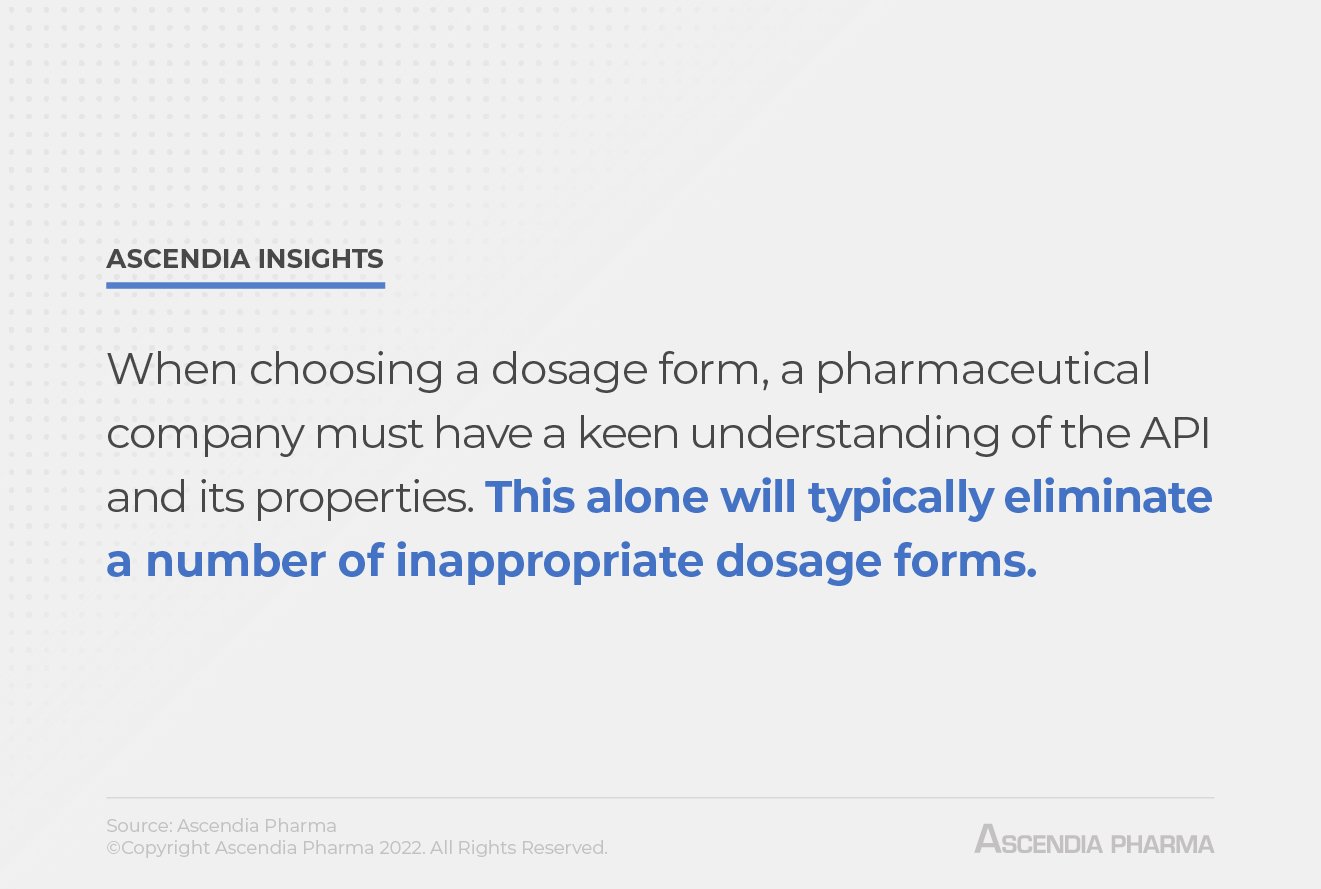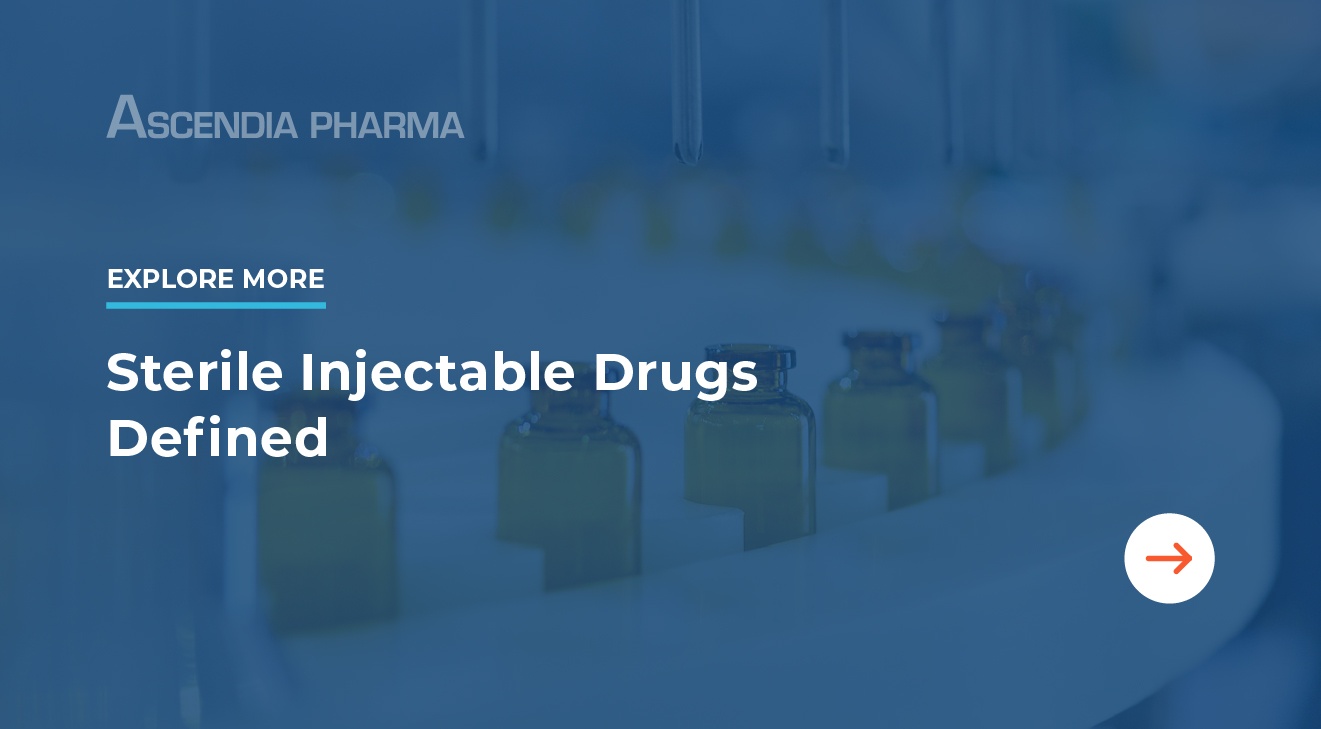Types of Sterile Dosage Forms (and How to Choose)
Sterile dosage forms are pharmaceutical drug preparations that must be free of contamination because they bypass the body’s usual defenses against infection. The manufacture of sterile dosage forms is highly regulated and requires specialized equipment and protocols.
In this article, we will discuss how to choose among dosage forms and routes of administration. We’ll also dig into the different types of sterile dosage forms and their manufacturing.

Dosage Form Definition and Classification: How to Choose
A dosage form is the preparation in which a pharmaceutical drug is manufactured, either for the market or for clinical research. The form includes the active pharmaceutical ingredient (API), the excipients, and their configuration. Dosage forms can be solid, liquid, or semisolid, and their routes of administration can be enteral (oral, sublingual, buccal, or rectal), parenteral (injectable), or topical, among others.
Choosing a dosage form depends on a number of factors. First, a pharmaceutical company must have a keen understanding of the API and its properties. This alone will typically eliminate a number of inappropriate dosage forms. For example, many biologics are less stable than their small molecule counterparts and must be formulated with this in mind.
Next, patient experience is considered. How will an end user use or take the medication? A drug that has an unpleasant taste may not be suitable for oral liquid delivery, while a drug meant for young children may need to be in a syrup rather than tablet or capsule form. Manufacturing costs, logistics, and storage must be taken into consideration as well.
These factors are included in the Targeted Product Profile (TPP), an FDA guidelines-based document which describes product attributes and development goals. This is an iterative document that changes as a drug progresses through the development process.
>> Related Read – Liquid-Filled Capsule Manufacturers: What to Know
Types of Sterile Dosage Forms
Most drugs are administered orally and pass through the esophagus, stomach, and intestines. While it’s important that these drugs are free of contaminants, the stakes are a lot higher for medications that are not subject to the body’s natural defenses.
These medications must be administered via a sterile dosage form, requiring a preparation free of bacteria, viruses, and other microorganisms, along with dust, fibers, and foreign particles. Not only must the solution itself be sterile, but the primary packaging materials, too, must be sterile.
There are a few types of sterile dosage forms:
• Ophthalmic preparations are applied to or placed into the eyes. The most common types of ophthalmic preparations are eye drops, eye ointments, eye lotions, eye suspensions, eye gels, and contact lens solutions.
• Otic preparations are administered via the ear. They are typically used to treat conditions of the external and middle ear.
• Nasal preparations include mists and drops used to treat nasal symptoms and conditions of the nose.
• Pulmonary or inhalational preparations include aerosols for administration to the lungs and respiratory tract. They are commonly used to treat conditions like chronic obstructive pulmonary disease (COPD), asthma, and cystic fibrosis.
• Parenteral drugs are injected. Although parenteral technically means any preparation that bypasses enteral routes and is not absorbed through the digestive tract, the term is most commonly used to refer to sterile injectable dosage forms.
>> Related Read – Bioavailability Enhancement Techniques
Types of Parenteral Dosage Forms
Parenteral dosage forms present challenges for clinicians and patients because the route of administration is more difficult, but these forms also have some distinct advantages. For one, parenteral drugs are absorbed quickly, and they are 100 percent bioavailable, eliminating the possibility of first-pass effect. There are also circumstances in which a patient may not be able to take a medication by mouth, or when the correct dosage cannot be administered orally.
Parenteral dosage forms by route of administration are as follows:
Subcutaneous injections – These injections are administered into the fat tissue that lies between the skin and muscle, which means they require only a short, thin needle. Live vaccines and insulin are the two most common types of subcutaneous injections.
Intramuscular injections – Another common parenteral dosage form is intramuscular injections, which are administered deep into a muscle so they can be absorbed by the blood vessels. Annual influenza shots are an example of an intramuscular injection.
Intravenous injections – Intravenous, or IV, injections deliver a sterile injectable directly into the bloodstream through an injection into a vein.
Intraperitoneal injections – These injections, which include certain types of chemotherapy, are administered directly into the peritoneum or body cavity.
Intraosseous injections – Intraosseous injections are typically only considered when IV access is not possible, and thus they are rarely used. These injections involve inserting a needle into the bone marrow of a large bone.
Intracardiac injections – Like intraosseous injections, intracardiac injections are another type of injection typically used only in emergency situations. They involve injecting a sterile drug directly into the heart.
Intraarticular injections – Intraarticular injection administers a drug into a joint. Also known simply as joint injections, these are commonly used in the treatment of inflammatory joint conditions like rheumatoid arthritis, gout, and carpal tunnel syndrome.
Intracavernous injections – Intracavernous injections are administered at the base of the penis, and most often used to treat erectile dysfunction.
Sterile dosage forms for injection may be:
Injection – A liquid preparation of a drug substance or solution, like insulin.
For injection – Dry solids that are injected after being combined with a suitable vehicle.
Injectable emulsion – A liquid preparation of a drug that is dissolved in an emulsion medium.
Injectable suspension – A solid suspended in a suitable liquid medium to form an injectable liquid preparation.
For injectable suspension – A dry solid that forms an injectable suspension when combined with a suitable vehicle.
Another way to classify parenteral preparations is by dividing them into small and large volume parenteral drugs. Small volume parenteral drugs are injections that are packaged in containers of 100ml or less, while large volume parenteral drugs are aqueous solutions in volumes of at least 100ml. Plasma expanders, sodium chloride infusions, and dextrose are all examples of large volume parenteral drugs.
>> Related Read – Examples of Emulsion Drugs
Manufacturing Sterile Dosage Forms
Sterile dosage forms need to be manufactured using specialized protocols and equipment to prevent contamination. They must be guaranteed to be:
• Free of microorganisms, including bacteria, viruses, and other pathogens.
• Isotonic with blood plasma and body fluids.
• Free from pyrogens and toxins that cause a rise in body temperature.
• Free of foreign particles, including dust and fibers.
• Suitable pH, which is particularly important for ophthalmic formulations.
• Physically and chemically stable, not only at the time of manufacturing but also during storage.
The most common sources of contamination include people, HVAC systems, infiltration from adjacent spaces, and internal generation from the walls, floors, ceilings, and equipment inside a facility.
Any kind of contamination in a parenteral formulation can cause adverse effects or death, as these drugs bypass the skin and GI tract, which are the body’s first defenses against pathogens. Sterile dosage forms can be made sterile either through an end-to-end aseptic manufacturing process or through a process called terminal sterilization.
Terminal Sterilization
The goal of terminal sterilization is to ensure that an end-product is sterile. As with all drugs, the manufacturing process follows strict guidelines to avoid contamination, but because the drug is sterilized at the end of the manufacturing process, if contamination were to happen somewhere along the way, it’s not as much as a concern; any pathogens will be killed before a drug ends up in the hands of a consumer.
Steam autoclaves are the most common form of terminal sterilization; this type of sterilization exposes a drug to heat to kill any microorganisms that are present. Gamma-ray radiation is another form of terminal sterilization, which is used when heat isn’t an option. Both methods are used because they sterilize the outside of a container and the contents inside. Because the containers are sealed prior to sterilization, there’s no way for new pathogens to be introduced unless the packaging is compromised. Still another sterilization method is ethylene oxide gas, which kills pathogens on surfaces; this type of sterilization is often used for pre-filled syringes.
Terminal sterilization costs less than aseptic production, but it’s not a fit for all drugs.
Aseptic Manufacturing for Sterile Dosage Forms
While terminal sterilization is preferred because of its ease and cost-effectiveness, aseptic manufacturing is often needed, particularly for biologics, which are rarely stable enough to handle the terminal sterilization process.
Aseptic manufacturing is a strictly controlled process that seeks to eliminate any potential for contamination at every single step of manufacturing. Because there’s no final sterilization as there is with terminal sterilization, pathogens can be introduced to a drug at any stage of the manufacturing process.
Aseptic manufacturing requires sterile raw materials, sterile formulation, sterile containers and closures, sterile filling, and sterile packaging. While the drugs themselves cannot be sterilized in aseptic manufacturing, the containers and equipment used to manufacture them can be, often with the same methods used for terminal sterilization.
Sterile dosage forms are manufactured in a cleanroom, and all personnel involved in aseptic manufacturing must wear full-coverage protective clothing, which minimizes the risk of pathogen shedding in the vicinity of drugs while they’re being manufactured. Once a drug is formulated, it will be filtered to remove microorganisms; testing occurs at several points in the manufacturing process to ensure an end-product that is free of contaminants, and batches that contain microorganisms are discarded.
Learn More About Sterile Dosage Forms
Ascendia specializes in the development of sterile dosage forms, including parenteral drugs for early-stage clinical trials. Contact us today to learn more about our services.
>> Related Read – Choosing a CDMO



